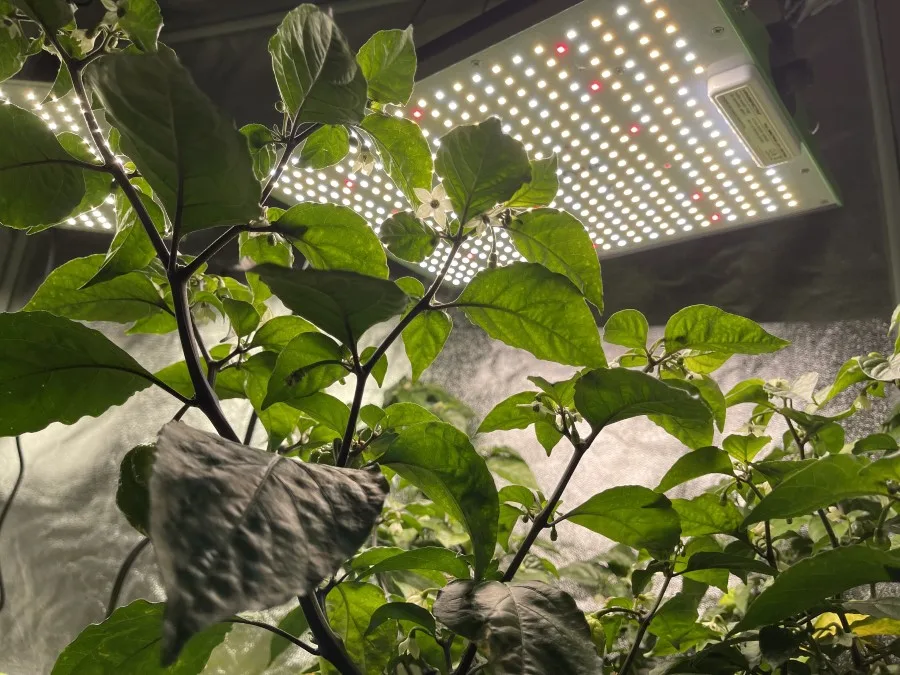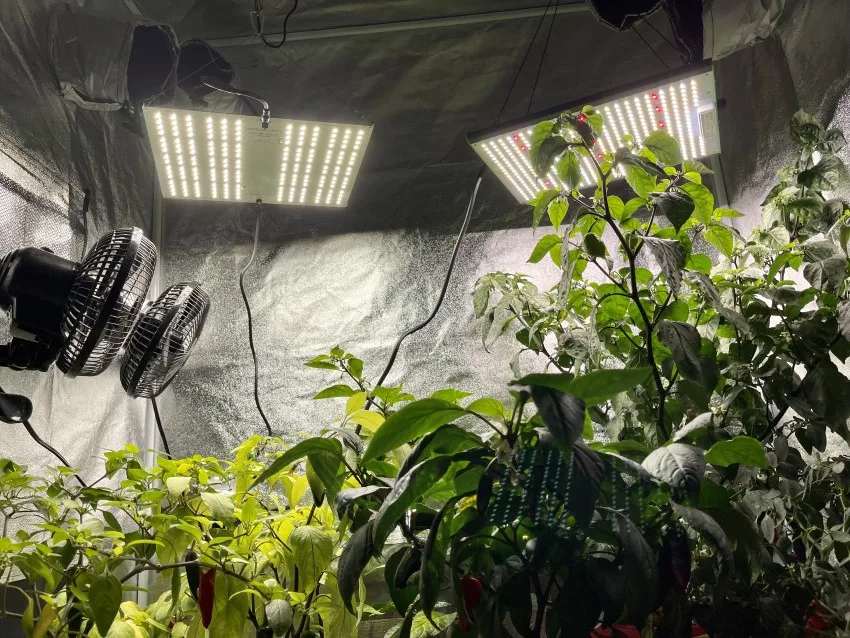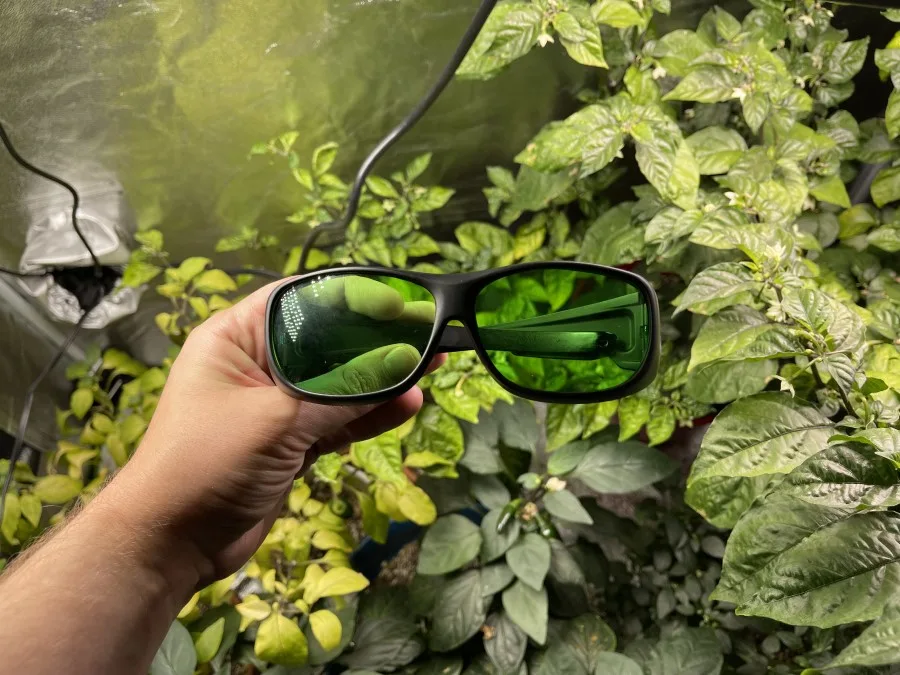Most people who use grow lights don’t think twice about whether they could cause permanent damage to your eyes. But, like natural sunlight, grow lights come with health risks and disadvantages.
Don’t get me wrong—grow lights are fantastic tools, but they have some characteristics that might be causing you more harm than you would have guessed.
Grow lights cause permanent damage to the eyes after months to years of exposure. Grow lights emit bright rays of ultraviolet (UV) light, like the sun, which can stress our eyes and cause damage to our lenses, corneas, retinas, and photoreceptors.
If you want the low-down of the damage your grow lights might be causing you, you’ve come to the right place! We’ll discuss how grow lights can damage the eye, teach you the effects of grow light exposure on your vision, and discuss how long it takes to start seeing–or, not seeing, but sensing–symptoms of overexposure. Then, we’ll share some tips for protecting your eyes from your grow lights.
As an Amazon Associate, I earn from qualifying purchases.

Are Grow Lights Bad for Your Eyes?
Grow lights are relatively bad for your eyes. All lights contribute to stress and damage to the eyes. However, highly concentrated blue light with high UV radiation, like that found in grow lights, is particularly damaging to the cornea and retina since it puts stress on the eye.
The main factors that make grow lights harmful to our eyes are the UV wavelengths they emit and the pathway of the ray, which is often very narrow. Let’s take a closer look at these characteristics and discover why they matter for your eyesight.
UV Radiation From Grow Lights Damages Your Eyes
Grow lights simulate sunlight, which is how they aid plants in photosynthesis. However, that means that looking directly at a grow light is like looking into the sun, which you may or may not know, is very bad for your eyes.
Grow lights shine light in the full spectrum of wavelengths, which we see as color. Grow lights cover the infrared range first, representing the lowest light frequency. However, they also emit blue and ultraviolet light, which are high-frequency rays that damage our eyes.
When we look at a light that contains UV rays, our eyes attempt to absorb the wavelengths that make up the light, including the most harmful ones, UV-A and UV-B rays.
UV-B rays harm our skin, causing sunburns, wrinkles, and skin cancer, while the lower-frequency UV-A rays cause stress on our eyes and minor skin damage.
This damage results from our inability to see and perceive the colors in these wavelengths. To protect our eyes from the high-frequency rays, the cornea, vitreous humor, photoreceptors, and lens of your eye will physically block out the UV light, shifting and narrowing your eyes’ focus to protect your vision.
However, this process of blocking out UV light can tire your eyes, causing stress.
An example of this phenomenon is the blotch or halo of white light you see after looking at the sun, which is a reaction that occurs as your eyes attempt to refocus and absorb light. For a quick explanation of how our eyes adjust to bright UV lights, you may want to watch this brief video from STAT, a national publication focused on telling compelling stories about health, medicine, and scientific discovery:
LED Grow Lights Distribute Light in Bright, Narrow Pathways
While any grow light that creates UV light will harm your eyes to some degree, LED grow lights have another characteristic that may make them even more damaging to our eyes.
If you compare an LED grow light with a standard incandescent light bulb, you’ll likely notice some fundamental differences in how the fixture disperses light.
You might first notice that LED lights contain many tiny bulbs, while a standard light bulb only has one little filament that creates light. This is one factor that makes LED grow lights more harmful to our eyes than a standard light bulb.
The tiny bulbs in these LED grow lights are incredibly concentrated and shine like lasers, sending a bright, narrow ray of light down and away from the light bulbs.
This high-frequency, bright ray of LED grow lights can be very damaging to your eyes if you look directly at it since the UV light will shoot its way down through your eye lens and into the retina, where your photoreceptors will attempt to block out the light as quickly as possible.
As this occurs, your eyes will refocus, which can exhaust your eyes over time, leading to short-and long-term damage.
As an example of how this happens, a news story from NBC’s 2020 investigated the harmful effects of UV germicidal lamps, which became very popular during the Coronavirus pandemic. These lights emit UV-C wavelengths, which have an even higher frequency than the UV-B light that grow lights emit.
These UV-C lights were so damaging to people that they developed burns on their cornea, also called photokeratitis, within days of exposure.
Other Related Grow Light Articles

Can Grow Lights Cause Permanent Eye Damage?
Grow lights cause permanent eye damage, wearing down your cornea, retina, photoreceptors, and vitreous humor. Although it takes prolonged exposure for the light to noticeably damage your eyes, the stress from looking directly at a grow light will have lasting effects.
The permanent symptoms of overexposure to grow lights that contain UV-A and UV-B rays include:
- Corneal damage. Corneal damage is the most common result of overexposure to UV light from grow lights. It occurs because your cornea attempts to absorb the UV light before it damages your retina and photoreceptors. It doesn’t take much exposure to develop damage to the cornea.
- Cataracts. Overexposure to light can lead to cataracts, a clumping of the proteins in your eye. Stress from UV exposure can increase your chances of developing cataracts earlier in life.
- Macular degeneration. According to ophthalmologists at the University of Wisconsin, macular degeneration is the most common cause of vision loss. It is a disorder characterized by loss of vision from the center of the eye, degradation of photoreceptors, and spotty or blurry vision. This symptom is often age-related, although it is also a result of overexposure to bright UV light.
- Melanoma and carcinoma of the eyelid. Melanoma and carcinoma of the eyelid result from UV-A exposure. Grow lights expose you to these rays.
In addition to these long-term effects, UV grow light exposure has a few short-term effects. Photokeratitis is one of the most common of these curable symptoms. It is much like a sunburn to the eye and will heal over a few days with the right care.
How Long Does it Take for Grow Lights to Damage Your Eyes?
While short-term damage like photokeratitis and temporary eye stress may occur on the same day you look at a grow light, it will take months to years of exposure to develop long-term symptoms.
Although it only takes a short amount of time of direct exposure to a grow light to develop eye sensitivity, inflammation, and temporary “halos” in your vision, it will take much longer to develop symptoms such as macular degeneration or corneal damage.
Still, it’s worth mentioning that the brightness of your grow light, the sensitivity of your eyes, and your environment will affect the damage your grow light can do.
For example, you may not experience short-term damage if you never look directly into the light, but you may experience long-term damage after years of using a high-brightness light in a closed room.
The effects of the grow light are the same as the effects of sunlight—it takes years of time and exposure for you to develop issues like skin cancer or permanent eye damage.

Ways to Protect Your Eyes When Working With Grow Lights
To protect your eyes when working with grow lights, wear sunglasses with frontal and side coverage, wear SPF sunscreen, and avoid looking directly at the grow lights. Ideally, you should turn off your grow lights when working with your plants.
Protecting your eyes from grow light damage is crucial, especially when using powerful HPS or LED lights.
So, let’s look at some guidelines that you should consider following if you want to protect your eyes:
- Wear sunglasses when you’re working under grow lights. Sunglasses should have side coverage and polarized lenses to ensure that you block out all of those high-frequency UV rays. We use the VIVOSUN Indoor Hydroponic LED Grow Room Glasses which you can find on Amazon. They are perfect for the job since they block out both UV-A and UV-B light from the front and sides. Plus, these are inexpensive and come with a case.
- Never look directly into the light. This one goes without saying, but it’s essential to remember to never look straight into your grow lights, especially if they are LED or HPS, with or without eye protection. Your eyes will thank you!
- Wear facial sunscreen. Sunscreen is always recommended since it will protect your face from UV damage. Since we’re talking eyes today, an SPF sunscreen for your face will help prevent diseases such as melanoma and carcinoma of the eyelid and the other sensitive, thin skin around your eyes. Plus, it prevents wrinkles, too.
- Limit your grow light exposure. Avoid working in the room when your grow light is on. If you want to water or tend to your plants in the area, turn off the grow light when you work and then turn it on again before leaving.
Closing Thoughts
Grow lights are potent lights that work like the sun, feeding plants and potentially causing damage to our skin and eyes. The UV light that these fixtures emit can cause short-term and permanent damage to your eyes’ corneas, retinas, lenses, and photoreceptors, so it is critical to protect yourself and never, under any circumstances, look directly into the light.
If you follow the tips provided, you should be able to use your grow light without ever experiencing the symptoms of overexposure.
